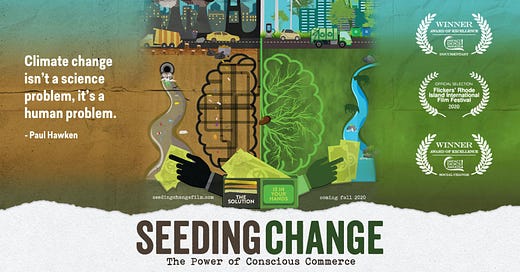Seeding Change: The Power of Conscious Commerce
This Amazon Prime film is more a call to arms for climate change warriors than pure documentary, but its message of combining profits with global stewardship resonates.
“Seeding Change: The Power of Conscious Commerce” is less a pure observational/exploratory documentary than a call to arms for climate change warriors. At 51 minutes, it’s the sort of thing you’d expect to see at a U.N. conference on warming than in your local cinema.
But its message, that it is possible for companies to combine profits with stringent stewardship of global resources and communities, still resonates powerfully. Directed by Richard Yelland, it interviews dozens of advocates and corporate honchos who speak knowingly about how the old model of plowing through forests and exploiting indigenous labor for short-term financial gain is always a loser in the long run.
It mostly focuses on South America and the Amazon regions, though its message is universal.
Some of what the companies are doing is truly innovative, next-level thinking — the sort of ideas batted around at a brainstorming session actually put into action.
Sambazon trades mostly in acai berries, which you’ve probably seen hawked at your local grocer as a breakfast bowl. (I was today years old, while watching this film, when I learned it’s pronounced “ahs-ah-EE,” not “ah-kigh.”) They can only be harvested by climbing palm trees, which previously had been clear-cut for wood or heart of palm.
By partnering with local workers, they’ve set up a worldwide trade for acai products while protecting the forest. And they plow some of the revenues back into building schools and wells for the villagers.
They call it a “triple bottom line” — making money, preserving nature and building up the local work force.
Other companies touched upon include Outerknown, which makes clothing and gear from the materials that other manufacturers throw away, The Good Bean, Numi tea, OSC2 and others forging a similar path. Their goal is to build, not exploit the continent’s native communities, and find ways to harvest its resources in a responsible, sustainable way.
One concept I found most interesting was the idea of intercropping, which is to say using the same land to grow multiple types of plants rather than having acres upon acres of soy or corn, which depletes the soil and strips away natural ecosystems. With intercropping, you’ll have different levels of trees, bushes and ground cover in the same space — just as they would grow naturally. Animals can continue to live there, and humans traipse in on foot to reap the rewards.
You might yield fewer crops per acre than with big machinery, but this sort of agriculture can thrive over time rather than stripping away the land. We are shown large swaths of the Amazon that have been turned into virtual deserts as a result of nearsighted exploitation.
Yes, some of the folks who show up in this documentary are the predictable types — I lost count of how many guys were rocking seashell bracelets or necklaces. They’re crunchy, modern-day hippies who we might be tempted to snicker at — but also real do-gooders making a difference for the planet.





